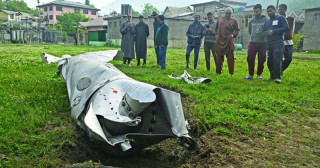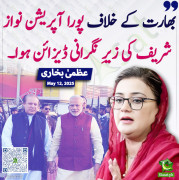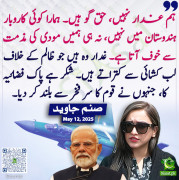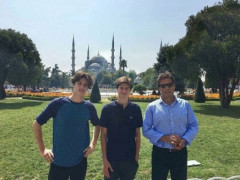NasNY
Chief Minister (5k+ posts)
List of Pakistani inventions and discoveries
From Wikipedia, the free encyclopedia

This article lists inventions and discoveries made by scientists with Pakistani nationality within Pakistan and outside the country, as well as those made in the territorial area of what is now Pakistan prior to the independence of Pakistan in 1947.
Contents
Indus Valley civilisation
Main article: List of inventions and discoveries of the Indus Valley Civilization

Computer-aided reconstruction of Harappan coastal settlement in Pakistan on the westernmost outreaches of the civilization
Main article: Taxila


The Ancient University of Taxila in Pakistan.
Pakistan was the seat of ancient learning and some consider Taxila to be an early university [SUP][12][/SUP] [SUP][13][/SUP] [SUP][14][/SUP] or centre of higher education,[SUP][15][/SUP] others do not consider it a university in the modern sense, [SUP][16][/SUP] [SUP][17][/SUP] [SUP][18][/SUP] in contrast to the later Nalanda University.[SUP][18][/SUP][SUP][19][/SUP][SUP][20][/SUP]
Takshashila is described in some detail in later Jātaka tales, written in Sri Lanka around the 5th century CE.[SUP][21][/SUP] Generally, a student entered Taxila at the age of sixteen. The Vedas and the Eighteen Arts, which included skills such as archery, hunting, and elephant lore, were taught, in addition to its law school, medical school, and school of military science.[SUP][22][/SUP]
Post-independence
Main article: History of Pakistan
Agriculture


Standard model of Electroweak Interaction.


Schematic representation of an implanted Ommaya reservoir.


The boot sector of an infected floppy.
http://en.wikipedia.org/wiki/List_of_Pakistani_inventions_and_discoveries
From Wikipedia, the free encyclopedia

This article lists inventions and discoveries made by scientists with Pakistani nationality within Pakistan and outside the country, as well as those made in the territorial area of what is now Pakistan prior to the independence of Pakistan in 1947.
Contents
- 1 Indus Valley civilisation
- 2 Centers of ancient learning in Pakistan
- 3 Post-independence
- 4 See also
- 5 References
- 6 External links
Indus Valley civilisation
Main article: List of inventions and discoveries of the Indus Valley Civilization

Computer-aided reconstruction of Harappan coastal settlement in Pakistan on the westernmost outreaches of the civilization
- Button, ornamental: Buttons—made from seashell—were used in the Indus Valley Civilization for ornamental purposes by 2000 BCE.[SUP][1][/SUP] Some buttons were carved into geometric shapes and had holes pieced into them so that they could attached to clothing by using a thread.[SUP][1][/SUP] Ian McNeil (1990) holds that: "The button, in fact, was originally used more as an ornament than as a fastening, the earliest known being found at Mohenjo-daro in the Indus Valley. It is made of a curved shell and about 5000 years old."[SUP][2][/SUP]
- Cockfighting: Cockfighting was a pastime in the Indus Valley Civilization in what today is Pakistan by 2000 BCE[SUP][3][/SUP] and one of the uses of the fighting cock. The Encyclopdia Britannica (2008)—on the origins of cockfighting—holds: "The game fowl is probably the nearest to the Indian red jungle fowl (Gallus gallus), from which all domestic chickens are believed to be descended...The sport was popular in ancient times in India, China, Persia, and other Eastern countries and was introduced into Greece in the time of Themistocles (c. 524–460 BCE). The sport spread throughout Asia Minor and Sicily. For a long time the Romans affected to despise this "Greek diversion," but they ended up adopting it so enthusiastically that the agricultural writer Columella (1st century CE) complained that its devotees often spent their whole patrimony in betting at the side of the pit."[SUP][4][/SUP]
- Furnace: The earliest furnace was excavated at Balakot, a site of the Indus Valley Civilization in the Mansehra District in the Hazara Province province of Pakistan, dating back to its mature phase (c. 2500-1900 BCE). The furnace was most likely used for the manufacturing of ceramic objects.[SUP][5][/SUP]
- Plough, animal-drawn: The earliest archeological evidence of an animal-drawn plough dates back to 2500 BCE in the Indus Valley Civilization in Pakistan.[SUP][6][/SUP]
- Ruler: Rulers made from Ivory were in use by the Indus Valley Civilization in what today is Pakistan and some parts of Western India prior to 1500 BCE.[SUP][7][/SUP] Excavations at Lothal (2400 BCE) have yielded one such ruler calibrated to about 1/16 of an inch—less than 2 millimeters.[SUP][7][/SUP] Ian Whitelaw (2007) holds that 'The Mohenjo-Daro ruler is divided into units corresponding to 1.32 inches (33.5 mm) and these are marked out in decimal subdivisions with amazing accuracy—to within 0.005 of an inch. Ancient bricks found throughout the region have dimensions that correspond to these units.'[SUP][8][/SUP] Shigeo Iwata (2008) further writes 'The minimum division of graduation found in the segment of an ivory-made linear measure excavated in Lothal was 1.79 mm (that corresponds to 1/940 of a fathom), while that of the fragment of a shell-made one from Mohenjo-daro was 6.72 mm (1/250 of a fathom), and that of bronze-made one from Harapa was 9.33 mm (1/180 of a fathom).'[SUP][9][/SUP] The weights and measures of the Indus civilization also reached Persia and Central Asia, where they were further modified.[SUP][9][/SUP]
- Stepwell: Earliest clear evidence of the origins of the stepwell is found in the Indus Valley Civilization's archaeological site at Mohenjodaro in Pakistan.[SUP][10][/SUP] The three features of stepwells in the subcontinent are evident from one particular site, abandoned by 2500 BCE, which combines a bathing pool, steps leading down to water, and figures of some religious importance into one structure.[SUP][10][/SUP] The early centuries immediately before the common era saw the Buddhists and the Jains of India adapt the stepwells into their architecture.[SUP][10][/SUP] Both the wells and the form of ritual bathing reached other parts of the world with Buddhism.[SUP][10][/SUP] Rock-cut step wells in the subcontinent date from 200-400 CE.[SUP][11][/SUP] Subsequently the wells at Dhank (550-625 CE) and stepped ponds at Bhinmal (850-950 CE) were constructed.[SUP][11][/SUP]
Main article: Taxila

The Ancient University of Taxila in Pakistan.
Pakistan was the seat of ancient learning and some consider Taxila to be an early university [SUP][12][/SUP] [SUP][13][/SUP] [SUP][14][/SUP] or centre of higher education,[SUP][15][/SUP] others do not consider it a university in the modern sense, [SUP][16][/SUP] [SUP][17][/SUP] [SUP][18][/SUP] in contrast to the later Nalanda University.[SUP][18][/SUP][SUP][19][/SUP][SUP][20][/SUP]
Takshashila is described in some detail in later Jātaka tales, written in Sri Lanka around the 5th century CE.[SUP][21][/SUP] Generally, a student entered Taxila at the age of sixteen. The Vedas and the Eighteen Arts, which included skills such as archery, hunting, and elephant lore, were taught, in addition to its law school, medical school, and school of military science.[SUP][22][/SUP]
Post-independence
Main article: History of Pakistan
Agriculture
- In 2013, a Pakistani firm invented a new formula to make fertilizers that cannot be converted into bomb-making materials. The firm, Fatima Fertilizer, had succeeded in making non-lethal alternatives to ammonium nitrate, a key ingredient in the fertilizers it makes. Fertilizers with ammonium nitrate, however, can easily be converted into bomb-making ingredients. This invention was praised by the Pentagon. “Such a long-term solution would be a true scientific breakthrough,” US Army Lieutenant General Michael Barbero, the head of the Pentagon’s Joint Improvised Explosive Device Defeat Organization, said in a statement. After this invention, CNN reported that the United States and Pakistan reached an agreement to jointly make fertilizers with non-explosive materials. But diplomatic sources told Dawn that an agreement could only be reached after the new material is tested. The sources said that US experts would soon visit Pakistan for testing the new material with experts from the Fatima Group, Pakistan’s major fertilizer manufacturer.[SUP][23][/SUP]
- Dr. Naweed Syed, a specialist in the field of biomedical engineering and member of the medicine faculty at the University of Calgary, became the first scientist who managed to "connect brain cells to a silicon chip". The discovery is a major step in the research of integrating computers with human brains to help people control artificial limbs, monitor people's vital signs, correct memory loss or impaired vision.[SUP][24][/SUP]
- Development of the world's first workable plastic magnet at room temperature by organic chemist and polymer scientist Naveed Zaidi.[SUP][25][/SUP][SUP][26][/SUP][SUP][27][/SUP]


Standard model of Electroweak Interaction.
- Discovery of electroweak interaction by Abdus Salam, along with two Americans Sheldon Lee Glashow and Steven Weinberg. The discovery led them to receive the Nobel Prize in Physics.[SUP][28][/SUP]
- Abdus Salam who along with Steven Weinberg independently predicted the existence of a subatomic particle now called the Higgs boson, Named after a British physicist who theorized that it endowed other particles with mass.[SUP][29][/SUP]
- The development of the Standard Model of particle physics by Sheldon Glashow's discovery in 1960 of a way to combine the electromagnetic and weak interactions.[SUP][30][/SUP] In 1967 Steven Weinberg[SUP][31][/SUP] and Abdus Salam[SUP][32][/SUP] incorporated the Higgs mechanism[SUP][33][/SUP][SUP][34][/SUP][SUP][35][/SUP] into Glashow's electroweak theory, giving it its modern form.
- Development of the SMB probe to detect heavy water leaks in nuclear power plants by Sultan Bashiruddin Mahmood[SUP][36][/SUP]


Schematic representation of an implanted Ommaya reservoir.
- The Ommaya reservoir - a system for the delivery of drugs (e.g. chemotherapy) into the cerebrospinal fluid for treatment of patients with brain tumours - was developed by Ayub K. Ommaya, a Pakistani neurosurgeon.[SUP][37][/SUP]
- A non-invasive technology for monitoring intracranial pressure (ICP) - developed by Faisal Kashif.[SUP][38][/SUP]
- Two medical devices - a pleuroperitoneal shunt and a special endotracheal tube to supply oxygen during fiberoptic bronchoscopy in awake patients - were invented by Sayed Amjad Hussain, a Pakistani American doctor from Peshawar, Pakistan. His work made him an inductee into the Medical Mission Hall of Fame.[SUP][39][/SUP][SUP][40][/SUP]
- A non-kink catheter mount was designed by a Pakistani doctor A. K. Jamil.[SUP][41][/SUP][SUP][42][/SUP] He also developed a simple device for teaching controlled ventilation (A device through which young doctors can be trained on artificial[SUP][43][/SUP] ventilation of the lungs without Operation theater and patient)


The boot sector of an infected floppy.
- A boot sector computer virus dubbed (c)Brain, one of the first computer viruses in history,[SUP][44][/SUP] was created in 1986 by the Farooq Alvi Brothers in Lahore, Pakistan, reportedly to deter piracy of the software they had written.[SUP][45][/SUP][SUP][46][/SUP]
- A Software simulation based on blast forensics designed by Pakistani computer scientist, Zeeshan-ul-Hassan Usmani, that can reduce deaths by 12 per cent and injuries by seven per cent on average just by changing the way a crowd of people stand near an expected suicide bomber.[SUP][47][/SUP]
- The Sagar Veena, a string instrument designed for use in classical music, was developed entirely in Pakistan over the last 40 years at the Sanjannagar Institute in Lahore by Raza Kazim.[SUP][48][/SUP][SUP][49][/SUP]
- The Human Development Index was devised by Pakistani economist Mahbub ul Haq in 1990 and had the explicit purpose "to shift the focus of development economics from national income accounting to people centered policies".[SUP][50][/SUP][SUP][51][/SUP]
- A team headed by Professor Sohail Khan, a Pakistani researcher at Loughborough University designed a clever lavatory that transforms human waste into biological charcoal and minerals. These can then be used as fuel or a form of conditioner for soil. It also produces clean water.[SUP][52][/SUP] The invention can lead to community-led total sanitation in the developing world. The challenge was set by Microsoft founder Bill Gates who wanted to improve sanitation for the poor and combat open defacation in countries where water supply and sewage pipe infrastructure is not widely available.[SUP][53][/SUP]
http://en.wikipedia.org/wiki/List_of_Pakistani_inventions_and_discoveries
- Featured Thumbs
- http://upload.wikimedia.org/wikipedia/commons/6/63/Ommaya_01.png
Last edited by a moderator:








































